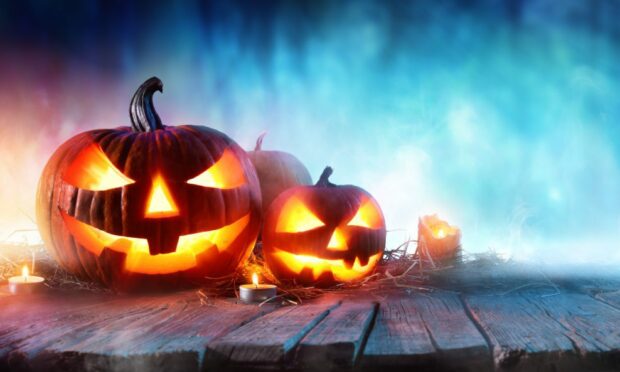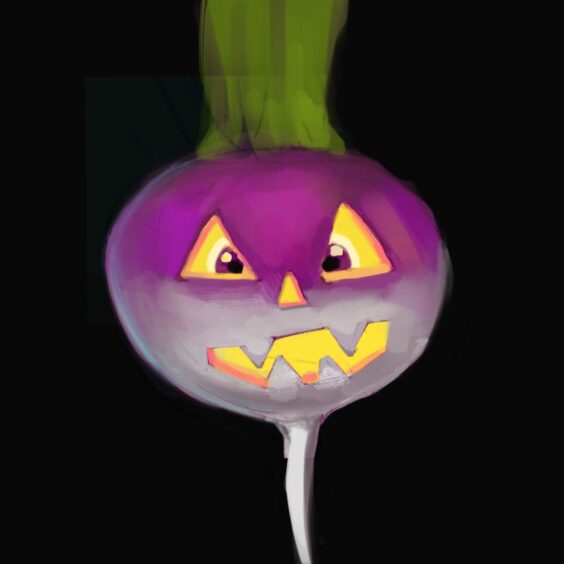Halloween is almost upon us, and one person who is nostalgic for past traditions is Mark Mechan.
He is a graphic designer who studied illustration at DJCA, who was inspired by conversations with his son, Elliot to write a children’s book, Tumshie, about old-fashioned Scottish Halloweens.
Mark grew up in Broughty Ferry and fondly recalls the smell of a slightly singed neep.
Childhood memories
The heady aroma will instantly transport him back to his childhood when he went guising and dookin’ for apples, not trick or treating.
At that time when his costumes were homemade rather than shop-bought, and turnips were the vegetable of choice for carving into lanterns, rather than pumpkins.
He said, “Carving a neep required both nerves of steel and the strength of an ox. Streets were quieter back then, but we always had to perform a party piece by reciting a poem or telling a joke.
“We got a few coins, monkey nuts not armfuls of sweets. My dad hollowed out a turnip and bent all the spoons in the kitchen. I think people my age have a collective memory and it‘s all in the book.”
He admits to having never seen a pumpkin in the shop as a child, adding, “It was an alien concept, an entirely American tradition.“
Can’t beat a neep
Mark admits, “I love the way a pumpkin looks but a neep is a Scottish cliché, a tough wee guy. It might not be gloriously brightly coloured but it is peppery to eat and tasty.”
This time of year is also the ideal time to tell dark ghostly stories.
Local historian, storyteller and library worker from Angus, Erin Farley, told me an old Aberdeenshire tale, which was first told by Stanley Robertson.
It concerns a tale of a hideous tattie bogle or scarecrow whose head was made from a turnip.
She explained the story has been around for generations, and a fuller version can be found in Aberdeen Folk Tales, a book by Sheena Blackhall and Grace Banks.
The spooky tale is set on a farm near Warlock Stone near Banchory. Farmer Akey Broon was facing ruin, his house had been burned down and all his cattle stolen, so he diversified into crops, which were then all eaten by crows.
Hideous scarecrow
The desperate farmer then decided to seek supernatural help at the Warlock’s Stone, summoning the ghostly presence of Colin Massie who had been executed for witchcraft in 1596.
In return for help scaring the crows, the ghostly apparition told Akey to make a hideous scarecrow. Its head was to be formed from a turnip pulled up from the fields and stuck on a pole. The eyes were taken from an owl and the mouth was cut from the corpse of a child who had died from smallpox.
If that wasn’t bad enough, the scarecrow’s arms and heart were sourced from the corpse of a hanged man and jacket buttons were made from body parts from seven different animals. The torso was then stuffed with straw and a magic enchantment then made the hideous monster come alive.
In the first year, the tattie bogle did the trick, scaring away all the crows and the farmer was rewarded with a bumper crop. However the second year, the crops failed.
Drunk and angered by all the horrible things he had done to make the scarecrow, he cut off the scarecrow’s left arm in a rage. The terrifying scarecrow spun round, and Akey, let out a blood-curdling scream, then tripped over and severed his own arm with his scythe.
No one will ever know…
To put an end to the supernatural scarecrow, the one-armed farmer crept up and swung again for its turnip head. What exactly happened next, no one will ever know but he was found unhinged, wandering in the fields the next day.
Erin said, “I hope this story hasn’t completely ruined your day…I learned (this story) a few years ago but haven’t told it for ages.
“It is such a brilliantly disturbing story about how tough it can be mentally, trying to live with the land when things go wrong, and the desperation it can bring up in people, as well as just being a great example of spooky lore.”
We won’t be able to displace the pumpkin from the top spot. But the fact that the Scottish climate is ideal for growing turnips, and our long-held tradition of turnip lanterns placed on the doorstep to ward off evil spirits on All Hallows’ Eve or Halloween, means we shouldn’t forget the ugly charm of our homegrown local seasonal neep.
- Tumshie – The Forgotten Halloween Turnip Lantern by Mark Mechan, Waverley Books, £7.99.




Conversation